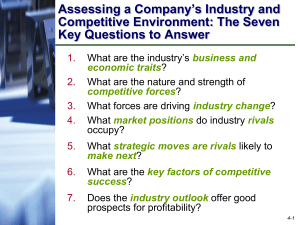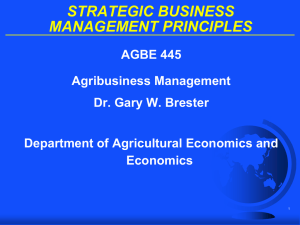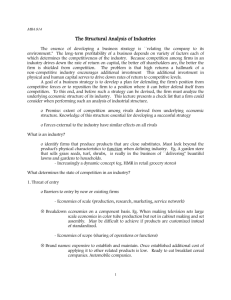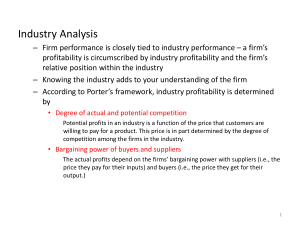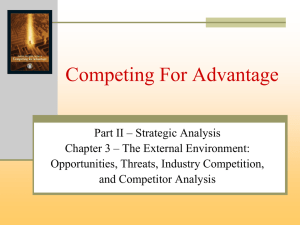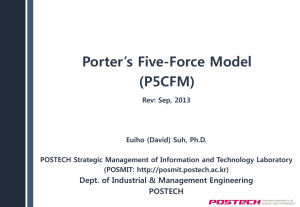What is Situation Analysis?
advertisement
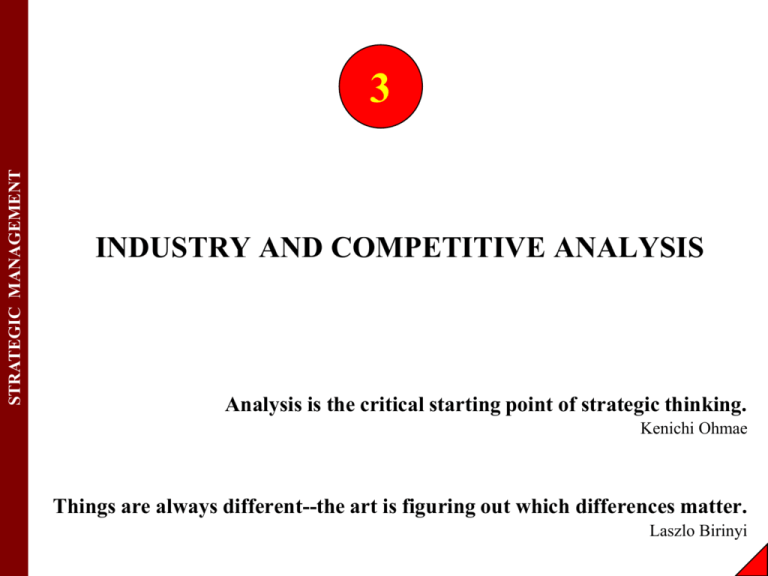
STRATEGIC MANAGEMENT 3 INDUSTRY AND COMPETITIVE ANALYSIS Analysis is the critical starting point of strategic thinking. Kenichi Ohmae Things are always different--the art is figuring out which differences matter. Laszlo Birinyi What is Situation Analysis? INDUSTRY & COMPETITIVE ANALYSIS Company’s internal or micro-environment: Competencies, capabilities, resource strengths and weaknesses, and competitiveness. Company’s external or macro-environment: Dominant Industry Traits, Key Drivers, and overall Competitive conditions. A firm spend time to do Situational Analysis to better know its available choices. INDUSTRY & COMPETITIVE ANALYSIS Components of Macro-environment The Economy at Large Suppliers Rival Firms Substitutes COMPANY Buyers New Entrants IMMEDIATE INDUSTRY AND COMPETITIVE ENVIRONMENT INDUSTRY & COMPETITIVE ANALYSIS Strategic Thinking & Analysis Leads to Good Strategic Choices Social, political, regulatory and community factors Competitive conditions and industry attractiveness Company opportunities and threats to company’s well-being Company’s Strategic Situation Resource strengths, capabilities, and weaknesses Influences of key executives Shared values and company culture External Factors Determine relevance of internal and external factors Identify and evaluate alternatives Internal Factors Craft the strategy Strategic Thinking & Analysis Leads to Good Strategic Choices INDUSTRY & COMPETITIVE ANALYSIS Assess Industry & Competitive Conditions 1. Industry’s dominant economic traits. 2. Nature of competition & strength of competitive forces. 3. Drivers of industry change. 4. Competitive position of rivals. 5. Strategic moves of rivals. 6. Key success factors. 7. Conclusions about industry attractiveness. Identify Strategic Options Assess Company Situation 1. Assessment of company’s present strategy. 2. Resource strengths and weaknesses, market opportunities, and external threats. 3. Company’s costs compared to rivals. 4. Strength of company’s competitive position. 5. Strategic issues that need to be addressed. for the Company Select the Best Strategy INDUSTRY & COMPETITIVE ANALYSIS Industry & Competitive Environment – Key Considerations 1. Industry’s dominant Economic traits. 2. Competitive Forces, and strength of each Force. 3. Change Drivers in the industry. 4. Competitor Analysis. 5. Strategic moves of Rivals. 6. Key Success Factors. 7. Conclusion: Overall Industry Attractiveness. Question#1: Industry’s Dominant Economic Traits? INDUSTRY & COMPETITIVE ANALYSIS Market size, and average growth rate. Scope of competitive rivalry. Number of competitors, and their relative sizes & their growth trends. Scale Economies and Experience Curve effects. Prevalence of Backward / Forward Integration. Scope Economies. Entry / Exit Barriers. Importance, Nature, and the pace of technological change. Product and Customer characteristics. Level of Standardization. Capacity utilization and resource requirements. Industry profitability. The Experience Curve Effect cumulative production volume increases because of: Accumulating production know-how. Growing mastery of the technology. The bigger the experience curve effect, the bigger the cost advantage of the firm with the largest cumulative production volume. Cost per Unit INDUSTRY & COMPETITIVE ANALYSIS An experience curve exists when a Company’s unit costs decline as its $1 $1 1 Million Units 0.90 0.80 0.70 2 Million Units 0.81 0.64 0.49 4 Million Units 0.729 0.512 0.343 8 Million Units Relevance of Key Economic Features INDUSTRY & COMPETITIVE ANALYSIS ECONOMIC FEATURE STRATEGIC IMPORTANCE Market growth rate: Small markets don’t tend to attract new firms; large markets attract firms looking to acquire rivals with established positions in attractive industries. Fast growth breeds new entry; slow growth spawns increased rivalry & shake-out weak rivals. Capacity surpluses/shortages: Surpluses push prices & profit margins down; shortages pull them up. Industry profitability: High-profit industries attract new entrants; depressed conditions lead to exit. Entry/exit barriers: High barriers protect positions and profits of existing firms; low barriers make existing firms vulnerable to entry. Product is big-ticket item for buyers: More buyers will shop for lowest price. Standard products: Buyers have more power because it’s easier to switch from seller to seller. Rapid technological change: Vertical integration: Raises risk; investments in technology facilities/equipment may become obsolete before they wear out. Big requirements make investment decisions critical; timing becomes important; creates a barrier to entry and exit. Raises capital requirements; often creates competitive & cost differences among fully vs. partially vs. non-integrated firms. Economies of scale: Increases volume & market share needed to be cost competitive. Rapid product innovation: Shortens product life cycle; increases risk because of opportunities for leapfrogging. Market Size: Capital requirements: INDUSTRY & COMPETITIVE ANALYSIS Question#2: What is Competition Like & How Strong are the Competitive Forces? FIVE FORCES MODEL OF COMPETITION Threat on Potential New Entrants Bargaining Power of Suppliers of Key Inputs Rivalry Among Competing Sellers Threat of Substitute Products Bargaining Power of Buyers Analyzing the 5-Competitive Forces INDUSTRY & COMPETITIVE ANALYSIS Assess strength of each of the five competitive forces (Strong/Moderate/Weak): Rivalry among Competitors. Competition from Substitute Products. Competitive threat from Potential Entrants. Bargaining power of Suppliers, and Supplier-seller Collaboration. Bargaining power of Buyers, and Buyer-Seller Collaboration. • Explain how each force acts to create Competitive pressure; what are the factors that cause each force to be strong or weak? • Assess the direction of force – Growing / Stagnant / Declining. • Decide whether overall competition (the combined effect of all 5 competitive forces) is Brutal, Fierce, Strong, Normal/Moderate, or Weak. Rivalry Among Competing Sellers INDUSTRY & COMPETITIVE ANALYSIS Usually the most powerful of the five forces; The big factor determining the strength of rivalry is how actively and aggressively are rivals employing the various weapons of competition in jockeying for a stronger market position and seeking bigger sales: Is price competition vigorous? Active efforts to improve quality? Are rivals racing to offer better performance features? Are rivals racing to offer better customer service? Lots of advertising/sales promotions? Active efforts to build a stronger dealer network? Active product innovation? Active use of other weapons of rivalry? What Causes Rivalry to be Stronger? INDUSTRY & COMPETITIVE ANALYSIS Active jockeying for position among rivals and frequent launches of new offensives to gain sales and market share: One or more firms initiates moves to bolster their standing at expense of rivals. Lots of firms that are relatively equal in size and capability. Slow Market Growth. Industry conditions tempt some firms to go on the offensive to boost volume and market share. Customers have low costs in switching to Rival Brands. A successful strategic move carries a big payoff. Costs more to get out of business than to stay in. Firms have diverse strategies, corporate priorities, resources, and countries of origin. Competitive Force of Potential Entry INDUSTRY & COMPETITIVE ANALYSIS Seriousness of Threat depends on: Barriers to entry; barriers exist when: Newcomers confront obstacles. Economic factors put potential entrant at a disadvantage relative to incumbent firms. Reaction of existing firms to entry. Common Barriers to Entry INDUSTRY & COMPETITIVE ANALYSIS Sizable Economies of Scale. Inability to gain access to specialized technology. Difficulties in gaining access to distribution channels. Regulatory policies, tariffs, trade restrictions. Large Capital requirements &/or other specialized resource requirements. Existence of strong Learning / Experience curve effects. Cost disadvantages independent of size. Strong brand preferences, and customer loyalty. Competitive Force of Substitute Products INDUSTRY & COMPETITIVE ANALYSIS Concept: Substitutes matter when customers are attracted to the products of firms in other industries. Examples: Eyeglasses vs. Contact Lens. Sugar vs. Artificial Sweeteners. Newspapers vs. TV vs. Internet. eMail vs. Overnight Delivery. How to Tell Whether Substitute Products are a Strong Force? INDUSTRY & COMPETITIVE ANALYSIS Competitive threat of substitutes is stronger when they are: Readily available. Attractively priced. Believed to have (at least) comparable or (even) better performance features. Customer switching costs are low. Customer loyalty is low. Key Indicators: Rapid growth in the Sales / Profits of the Substitutes. Producers of Substitutes planning to add (or adding) Capacity. Competitive Pressures: Suppliers & Supplier-Seller Collaboration INDUSTRY & COMPETITIVE ANALYSIS Whether Supplier-Seller Relationships represent a weak or strong competitive force, primarily depends on: Whether suppliers can exercise sufficient bargaining leverage to influence terms of supply in their favor. Extent and competitive importance of collaborative partnerships between one or more sellers and their suppliers. Competitive Force of Suppliers INDUSTRY & COMPETITIVE ANALYSIS Suppliers are a strong competitive force when: …item makes up large portion of product costs, is crucial to production process, and / or significantly affects product quality. …it is costly for buyers to switch to other / new suppliers. …they have good reputations and also growing demand. …they can supply a component cheaper than its rivals, and than the industry members can make it themselves. …they do not have to contend with substitutes. …buying firms are not important customers. Competitive Pressures: Sellers-Suppliers Collaboration INDUSTRY & COMPETITIVE ANALYSIS Rival sellers are forming long-term strategic partnerships with select suppliers to: Promote just-in-time deliveries and reduced inventory and logistic costs. Speed availability of next-generation components. Enhance quality of parts being supplied. Reduce suppliers’ costs which paves way for lower prices on items supplied. Competitive advantage potential may accrue to industry rivals doing the best job of managing supply-chain relationships. Suppliers are a stronger force the more they can exercise power over: Prices charged. Quality and performance of items supplied. Reliability of deliveries. Competitive Pressures: Buyers-Seller-Buyer Collaboration INDUSTRY & COMPETITIVE ANALYSIS Whether seller-buyer relationships represent a weak or strong competitive force depends on: Whether buyers have sufficient bargaining leverage to influence terms of sale in their favor. Extent and competitive importance of collaborative partnerships between one or more sellers and their customers. Competitive Force of Buyers INDUSTRY & COMPETITIVE ANALYSIS Buyers are a strong competitive force when: they are large and purchase a sizable percentage of industry’s / seller’s product. they buy in large quantities. they can integrate backward. industry’s product is standardized. their costs in switching to substitutes (or competitive brands) are low. they can purchase from several sellers. product purchased does not save buyer money. INDUSTRY & COMPETITIVE ANALYSIS Competitive Pressures: Sellers-Buyers Collaboration Partnerships are an increasingly important competitive element in business-tobusiness relationships: Collaboration may result in mutual benefits regarding: Just-in-time deliveries. Order processing. Electronic invoice payments. On-line sharing of sales at the cash register. Competitive advantage potential may accrue to industry rivals who do the best job of managing seller-buyer partnerships. INDUSTRY & COMPETITIVE ANALYSIS Strategic Implications of the 5 Competitive Forces Competitive environment is unattractive from the standpoint of earning good profits when: Rivalry is strong. Entry barriers are low and new entry is likely. Competition from substitutes is strong. Suppliers have considerable bargaining power. Customers have considerable bargaining power. Competitive environment is ideal from a profit-making standpoint when: Rivalry is moderate (not low). Entry barriers are high and no firm is likely to enter. Good substitutes do not exist, or not in a position to challenge. Suppliers and customers are in a weak bargaining position. Coping with the 5 Competitive Forces INDUSTRY & COMPETITIVE ANALYSIS Objective is to craft a strategy: To insulate firm from competitive forces. To help make the “rules,” placing added pressure on rivals. Which allows firm to define the business model for the industry. Question#3: What Forces are at Work to Change Industry Conditions? INDUSTRY & COMPETITIVE ANALYSIS Industries change because forces are driving industry participants to alter their actions. Driving forces are the major underlying causes of changing industry and competitive conditions. ANALYZING DRIVING FORCES Identify those forces likely to exert greatest influence over next 1-3 years; Usually no more than 3 - 4 factors qualify as real drivers of change. • Assess impact: What difference will the forces make - favorable? unfavorable? Common Types of Driving-Forces INDUSTRY & COMPETITIVE ANALYSIS e-commerce opportunities. Globalization. Long-term industry growth rate. Who buys the product and how they use it. Innovation: Product, Technological, Marketing etc. Entry or exit of major firms. Diffusion of technical knowledge. Changes in cost and efficiency. Market shift from standardized to differentiated products (or vice versa). Policies / legislation. Societal concerns, attitudes, and lifestyles. Degree of uncertainty and risk. Environmental Scanning INDUSTRY & COMPETITIVE ANALYSIS Definition: Monitoring and interpreting sweep of social, political, economic, ecological, and technological events to spot budding trends that could eventually impact industry. Purpose: Raise consciousness of managers about potential developments that could: Have important impact on industry conditions. Pose new opportunities and threats. Question#4: Assessment of Competitive Positions INDUSTRY & COMPETITIVE ANALYSIS STRATEGIC GROUP MAPPING Firms in same strategic group have two or more competitive characteristics in common: Sell in same price/quality range. Cover same geographic areas. Be vertically integrated to same degree. Have comparable product line breadth. Emphasize same types of distribution channels. Offer buyers similar services. Use identical technological approaches. INDUSTRY & COMPETITIVE ANALYSIS World Automobile Industry – Strategic Groups Map INDUSTRY & COMPETITIVE ANALYSIS How to Construct a Strategic Group Map STEP 1: Identify competitive characteristics that differentiate firms in an industry from one another. STEP 2: Plot firms on a two-variable map using pairs of these differentiating characteristics. STEP 3: Assign firms that fall in about the same strategy space to same strategic group. STEP 4: Draw circles around each group, making circles proportional to size of group’s respective share of total industry sales. Variables selected as axis should not be highly correlated. Variables do not have to be either quantitative or continuous. If more than 2 good competitive variables can be used, several maps can be drawn. Types of Video Game Suppliers/Distribution Channels INDUSTRY & COMPETITIVE ANALYSIS Video Game Industry – Strategic Groups Map Arcades Arcade operators Home PCs Sony, Sega, Nintendo, several others Video game consoles Online/Internet Publishers of games on CDROMs MSN Gaming Zone, Pogo.com, America Online, HEAT, Engage, Oceanline, TEN Low (Coin-operated equipment) Medium (Console players cost $100-$300) High (Use PC) Overall Cost to Players of Video Games INDUSTRY & COMPETITIVE ANALYSIS Interpreting Strategic Group Maps Driving forces and competitive pressures often favor some strategic groups and hurt others. Profit potential of different strategic groups varies due to strengths and weaknesses in each group’s market position. The closer strategic groups are on map, the stronger the competitive rivalry among member firms tends to be. INDUSTRY & COMPETITIVE ANALYSIS Question#5: Strategic Moves Rivals are Likely to Make Next? A firm’s own best strategic moves are affected by Current strategies of competitors and Future actions of competitors. • Profiling key rivals involves gathering competitive intelligence about their Current strategies, Most recent moves, Resource strengths and weaknesses, Announced plans. Competitor Analysis INDUSTRY & COMPETITIVE ANALYSIS Successful strategists take great pains in scouting competitors to: Understand their strategies. Watch their actions. Evaluate their vulnerability to driving forces and competitive pressures. Size up their resource strengths and weaknesses and their capabilities. Try to anticipate rivals’ next moves. Categorizing Competitor Objectives & Strategies INDUSTRY & COMPETITIVE ANALYSIS Competitive Scope •Local •Regional •National •MultiCountry •Global Strategic Intent • Be dominant leader • Overtake industry leader • Be among industry leaders Market Share Objective • Aggressive expansion via acquisition & internal growth • Expansion via internal growth • Expansion via • Move up a notch acquisition in rankings • Hold on to • Maintain current present share position Competitive Position • Getting stronger; on the move • Wellentrenched • Stuck in the middle of the pack • Going after a different position • Struggling; losing ground • Give up present • Retrenching to • Just survive share to achieve a position that short-term profits can be • Move into top 10 defended Strategic Posture • Mostly offensive • Mostly defensive • Combination of offensive & defensive • Aggressive risk-taker • Conservative follower Competitive Strategy • Striving for low-cost leadership • Pursuing differentiation based on Quality Service Technology superiority Breadth of product line Image & reputation More value for the money Other attributes • Focusing on market niche Predicting Moves of Rivals INDUSTRY & COMPETITIVE ANALYSIS Predicting rivals’ next moves involves: Analyzing their current competitive positions. Examining public pronouncements about what it will take to be successful in industry. Gathering information from grapevine about current activities and potential changes. Studying past actions and leadership. Determining who has flexibility to make major strategic changes and who is locked into pursuing same basic strategy. INDUSTRY & COMPETITIVE ANALYSIS Question#6: What are the Key Success Factors? Competitive elements most affecting every industry member’s ability to prosper: Specific strategy elements. Resources. Product attributes. Competencies. Competitive capabilities. KSFs spell the difference between Profit or loss; Competitive success or failure. Identifying Industry KSFs INDUSTRY & COMPETITIVE ANALYSIS Answers to three questions pinpoint KSFs: On what basis do customers choose between competing brands? What resources and competitive capabilities does a seller need to have to be competitively successful? How sellers to achieve a sustainable competitive advantage? KSFs consist of the 3 - 5 really major determinants of financial and competitive success in an industry. INDUSTRY & COMPETITIVE ANALYSIS Common Types of KSFs Technologyrelated Scientific research expertise; Product innovation capability; Expertise in a given technology; Capability to use Internet to conduct various business activities Manufacturingrelated Low-cost production efficiency; Quality of manufacture; High use of fixed assets; Low-cost plant locations; High labor productivity; Low-cost product design; Flexibility to make a range of products Distributionrelated Strong network of wholesale distributors/dealers; Gaining ample space on retailer shelves; Having company-owned retail outlets; Low distribution costs; Fast delivery Marketing-related Fast, accurate technical assistance; Courteous customer service; Accurate filling of orders; Breadth of product line; Merchandising skills; Attractive styling; Customer guarantees; Clever advertising Skills-related Superior workforce talent; Quality control know-how; Design expertise; Expertise in a particular technology; Ability to develop innovative products; Ability to get new products to market quickly Organizational capability Superior information systems; Ability to respond quickly to shifting market conditions; Superior ability to employ Internet to conduct business; More experience & managerial know-how Other types Favorable image/reputation with buyers; Overall low-cost; Convenient locations; Pleasant, courteous employees; Access to financial capital; Patent protection Question#7: Is the Industry Attractive or Unattractive & Why? INDUSTRY & COMPETITIVE ANALYSIS Objective: Develop conclusions about whether the industry and competitive environment is attractive or unattractive, both near- and longterm, for earning good profits. Principle: A firm uniquely well-suited in an otherwise unattractive industry can, under certain circumstances, still earn unusually good profits. Things to Consider in Assessing Industry Attractiveness INDUSTRY & COMPETITIVE ANALYSIS Industry’s market size and growth potential. Whether competitive conditions are conducive to rising/falling industry profitability. Will competitive forces become stronger or weaker. Whether industry will be favorably or unfavorably impacted by driving forces. Potential for entry/exit of major firms. Stability/dependability of demand. Severity of problems facing industry. Degree of risk and uncertainty in industry’s future. Industry & Competitive Situation Analysis INDUSTRY & COMPETITIVE ANALYSIS Two things to keep in mind: Evaluating industry and competitive conditions cannot be reduced to a formula-like exercise--thoughtful analysis is essential. Sweeping industry & competitive analyses need to done every 1-3 years.
